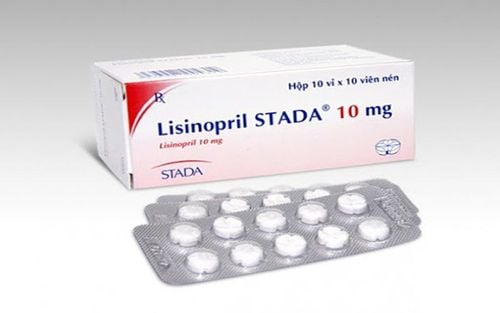This is an automatically translated article.
Lamepil 100 contains the main ingredient Lamotrigine 100mg, used alone or in combination with other medicines. It is used in the treatment of epilepsy and bipolar disorder.1. What does Lamepil 100 do?
The drug is indicated for use in cases such as:
Lamotrigin is indicated in the treatment of partial epilepsy in adults and children over 2 years old. Lamotrigin is also indicated as adjunctive treatment for the relief of convulsions caused by Lennox-Gastaut syndrome in elderly patients and in children over 2 years of age. Use in combination with certain antiepileptic drugs such as carbamazepine, phenytoin, phenobarbital, primidone, or lamotrigine valproate in the therapy of adults with partial-onset epilepsy. Lamotrigine is indicated for the treatment of bipolar disorder and for the relief of recurrent symptoms of affective disorder such as depression, mania, hypomania, and mixed psychosis. Do not use for patients with hypersensitivity to the ingredient or to any of its components.
When the drug is absorbed into the body, it works by reducing the nerve impulses that cause the seizure syndrome. It is effective in reducing symptoms such as confusion, uncontrollable twitching movements, loss of awareness, and reducing feelings of fear or anxiety.
2. Dosage and way of taking medicine
The dose of the drug will be specifically prescribed by the doctor for each patient depending on the level and condition of the patient's body response. Below is the dosage of the drug that the patient can refer to.
2.1. Treatment of epilepsy With patients from 2-12 years old:
Lamotrigin support for AED regimen used in week 1 and week 2 with a dose of 0.15mg/kg, divided into 1-2 doses per day. During week 3 and week 4 use 0.3 mg/kg, followed by maintenance dose of 1-5 mg/kg/day (maximum dose increase may be increased to 200 mg, dose dependent response of the body). Dosage of Lamotrigine in combination with carbamazepine, phenytoin, phenobarbital, or primidone: In weeks 1-2 use a dose of 0.6 mg/kg, divided into 2 doses per day, from weeks 3-4 use 1.2mg/kg/2 doses /day. Maintenance dose then use 5-15mg/kg (maximum use is 400mg/day) Patients over 12 years old
Dose of adjunctive drug for AED regimen: Use during week 1 and week 2 at the same dose. is 25 mg/kg, used every other day. During weeks 3 and 4, the dose is 25 mg/kg, daily followed by a maintenance dose of 100 to 400 mg/day or divided into 2 divided doses. Lamepil 100 in combination with carbamazepine, phenytoin, phenobarbital, or primidone for weeks 1-2 use a dose of 50mg/day, for 3-4 weeks take 100mg a day in 2 divided doses, then a maintenance dose of 300 to 500mg/day . 2.2. Treatment of Bipolar Disorder Use a dosage of lamotrigine of 200 mg/day
3. Overdose and how to handle it
Overdose of lamotrigine up to 15g will cause some undesirable side effects such as ataxia, nystagmus, increased convulsions, loss of consciousness, coma, and disruption of intraventricular conduction, Some severe cases have resulted in death.
Currently there is no specific antidote for lamotrigine. When an overdose is suspected, seek medical attention immediately. The doctor will usually order close observation of the patient's reactions. When necessary, emesis or gastric lavage may be indicated, using normal precautions to protect the respiratory tract.
4. Side effects
Blood and lymphatic system disorders: leukopenia, anemia, thrombocytopenia, decreased platelet concentration, aplastic anemia, decreased granulocyte count. Side effects lymphadenopathy, hemolytic anemia are very rare. Eye disorders: Very rare reactions such as visual disturbances causing blurred vision, rare reactions including conjunctivitis. Gastrointestinal disorders: Common reactions include nausea, vomiting, diarrhea, dry mouth; Uncommon reactions such as esophagitis, dyspepsia, abdominal pain, constipation, rectal bleeding, gastric ulcer, flatulence, loss of appetite. General disorders: Fatigue, pain, back pain, neck pain, chest pain, asthenia, fever, flu syndrome Hepatobiliary disorders: Including liver failure, liver dysfunction, increased liver function, pancreatitis Immune system disorders: Causes hypersensitivity syndrome (including symptoms such as fever, swollen lymph nodes, eye edema, blood and liver abnormalities, disseminated intravascular coagulation, multiple organ failure, vasculitis, progressive immunosuppression Infections and parasites: Infections, urinary tract infections Metabolism and nutritional disorders: Peripheral edema, weight loss, weight gain, edema Musculoskeletal and connective tissue disorders such as arthralgia, lupus-like reactions, myalgia, rhabdomyolysis, decreased bone mineral density, osteoporosis and fractures have been reported in patients on long-term treatment with lamotrigine. Headache, somnolence, tremor, insomnia, agitation, nystagmus, meningitis Rare reactions such as balance eye, dyskinesia, worsening of Parkinson's disease, extrapyramidal effects, increased convulsion frequency, convulsion convulsions, speech disorders, concentration disorders, memory loss, sensory impairment, decreased reflexes, increased reflexes, occurrence of suicidal behavior, emotional disturbances, abnormal gait, dizziness, action, abnormal thinking, migraine, mania. Psychiatric disorders: Frequently experiencing irritability and irritability, which can lead to depression and stress. Renal and urinary disorders: Frequent urination Reproductive and breast system disorders: Dysmenorrhea, vaginitis, amenorrhea, increased libido. Respiratory, thoracic and mediastinal disorders: Rhinitis, sinusitis, bronchitis, pharyngitis, increased cough, epistaxis, dyspnea, bronchospasm, apnea. Multiple and subcutaneous tissue disorders: rash, Stevens-Johnson syndrome, epidermal necrolysis, pruritus, contact dermatitis, dry skin, sweating, facial edema, photosensitivity, eczema, alopecia hair.
5. Drug interactions
Lamotrigine interacts with carbamazepine: Lamotrigine does not change the plasma concentration of carbamazepine but may cause symptoms such as dizziness, lightheadedness, and blurred vision in patients combining carbamazepine with lamotrigine. Lamotrigine interacts with oxecarbazepine and causes headaches, dizziness, nausea, and drowsiness when lamotrigine is co-administered with oxcarbazepine compared with lamotrigine alone or oxcarbazepine alone. Lamotrigine works with levetiracelam, lithinm or olanaapine. Lamotrigine interacts with valproate: Plasma concentrations decreased by an average of 25% over a 3-week period and then stabilized. Lamotrigine in interaction with phenytoin: Lamotrigine has no significant effect on phenytoin plasma concentrations. Carbamazepine, phenytoin, phenobarbital, or primidone interacts with lamotrigine: The addition of these AEDs reduces lamotrigine concentrations by approximately 40%. Methsuximide Interactions with Lamotrigine: Concomitant administration of methsuximide will result in decreased plasma concentrations of lamotrigine and more seriously may lead to loss of seizure control. Folic Acid Inhibitors: Lamotrigine is a dihydrofolate reductase inhibitor and should be considered when prescribing drugs that inhibit folic acid metabolism. Acetaminophen: The half-life and concentration of lamotrigine may be slightly reduced with high doses of acetaminophen. Alcohol or drugs that depress the central nervous system: Lamotrigine may increase the side effects of central nervous system depression. Contraceptives: In women taking lamotrigine, there have been reports of decreased lamotrigine concentrations after oral contraceptives and increased after cessation of oral contraceptives. Dosage adjustments are necessary to maintain clinical response when starting or stopping oral contraceptives during treatment with lamotrigine.
Please dial HOTLINE for more information or register for an appointment HERE. Download MyVinmec app to make appointments faster and to manage your bookings easily.













